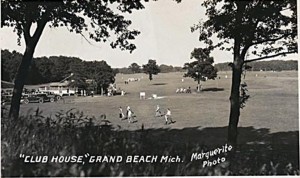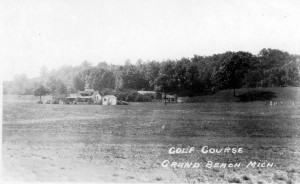From its beginnings in 1908, the founders of Grand Beach, Michigan (intiially known as Grand Beach Springs), aspired to create a summer playground for Chicagoans. With a picturesque wooded setting, beach access, and easy arrival via a short trip down the Michigan Central Railroad line, Grand Beach developed as a leisure destination in the first decades of the 20th-century. Golf became a principal form of recreation for the community in 1911, when developers Floyd R. Perkins and George H. Ely subdivided a second parcel called the Golf Addition to Grand Beach Springs. Perkins and Ely envisioned a nine-hole course at Grand Beach to provide a challenge to all levels of golfers. Their Grand Beach Company hired Scottish-born golf architect Thomas M. Bendelow to design the course during America’s pioneering era of golf design. Many of America’s early golf architects were of Scottish origin, coming to the U.S. to become course designers, greenskeepers and teachers.

Thomas M. Bendelow (1872-1936) is the most prolific of America’s pioneering golf architects, designing over 400 courses in the U.S. He was born in Aberdeen, Scotland, where he learned the game as a youth. After moving to the U. S. in 1885, Bendelow first went to work as a typesetter for the New York Herald. While working at the newspaper, he noticed an ad placed by the Pratt family of Long Island, New York. The family’s patriarch, Charles Pratt, was a pioneer in America’s petroleum industry and a part of theStandard Oil Company. In 1895, the Pratts were looking for a young golfer to teach them the game. Soon after responding to the ad, Bendelow began to lay out a short golf course on the grounds of the family estate on Long Island. Following his initial golf layout for the Pratts, Bendelow designed many rudimentary courses in New York State. Bendelow then served as manager and greenskeeper for Van Cortlandt Park in the Bronx, America’s first municipal golf course. A new opportunity came in the early 1900s when A. G. Spaulding & Brothers, a Chicago-based sporting goods company, hired Tom Bendelow to stake out golf courses across the U.S. Spaulding opened its first store in Chicago in 1876 and began producing golf equipment in 1884. Motivated by golf’s growing popularity in the early 1900s, Spaulding hired Bendelow to create new golf playgrounds to sell more golf clubs and balls to America’s new players. By 1920, Tom Bendelow left the company to become chief golf architect for the American Park Builders, a Chicago-based company that designed a number of courses in the metropolitan area. Later in his life, Bendelow lectured about golf architecture at the University of Illinois and wrote articles about the subject for a number of publications. Tom Bendelow died in 1936 at the age of 64 in River Forest, Illinois. According to Geoffrey S. Cornish and Ronald E. Whitten in The Architects of Golf, Tom Bendelow was involved in the design of at least 30 private and public golf courses in Michigan and over 60 courses in Illinois.

Tom Bendelow used a primitive staking method employed during the pioneering years of American golf, known facetiously as “Eighteen Stakes on a Sunday afternoon.” Early golf architects followed the existing contours of the land to stake out hold placement, usually in one day and given a fee. Usually, designers left the details of the design (such as size and placement of side traps and elevations of tees) to local people such as the golf course superintendent or even members of a country club. Often, because of the approach of this type of golf layout, courses laid out in the early years have been altered and remodeled. In the 20th-century, American golf architecture evolved from functional and amateur designs to aesthetically laid out courses. Bendelow also evolved as a designer, as time and experience would dictate. In his later years, Bendelow became a more proficient golf architect. In his designs, Bendelow is known for parallel fairways and implementing a pattern of one long and two short holes for each set of nine holes. In his penal approach to design, water hazards do not come into play, and a poor shot off the fairway will cost the golfer.
Through Chicago connections, Thomas Bendelow became the designer of the Grand Beach Golf Course in 1911. In February of that year, Perkins, Ely and the Grand Beach Company began development of the community’s second subdivision, the Golf Addition to Grand Beach Springs. New streets introduced to Grand Beach included Golf Road, Crescent Road, Royal Road, and Station Road. Abutting the Golf Addition subdivision was a new golf course, built at a cost of $10,000. To create the course, over 400 trees were removed in the timbered Grand Beach landscape. On July 18, 1911, the nine-hole Grand Beach Golf Course opened for play. Over 100 invitations were sent for its first event, attended by members of the Western Advertiser’s Golf Association and their wives. The course’s first guests arrived via a special train over the Michigan Central Railroad. Their scratch event, with 34 players, marked the opening of the golf course.
In October 1912, the Chicago Daily Tribune reported Grand Beach as “The Mecca of Golf:”
A superb golf course is already in use representing an actual money expenditure of many thousand dollars. This is one of the most picturesque and beautiful courses in the United States, and has few close seconds in England or on the continent. It was laid out by Tom Bendelow, the famous golf course expert, and closely approximates the links on the estate of the Duke of Devonshire, in the opinion of well-known Englishmen. The present course is being doubled in order to accommodate the greatly increased patronage.
Although real estate developers Ely and Perkins later expanded the Grand Beach Golf Course, today the course only retains its original nine-hole course. One hundred years later, the Grand Beach Golf Course continues to host events for all levels of golfers.
